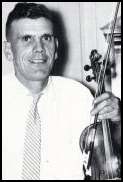Annotation:Pat Wilmot's: Difference between revisions
No edit summary |
m (Text replacement - "garamond, serif" to "sans-serif") |
||
| (5 intermediate revisions by one other user not shown) | |||
| Line 1: | Line 1: | ||
=='''Back to [[{{BASEPAGENAME}}]]'''== | =='''Back to [[{{BASEPAGENAME}}]]'''== | ||
---- | ---- | ||
<p><font face=" | <p><font face="sans-serif" size="4"> | ||
'''PAT WILMOT’S.''' Canadian, Reel. Canada, Cape Breton. G Major. Standard tuning (fiddle). AA'B. The tune is credited to John E. "Johnny" Wilmot | '''PAT WILMOT’S.''' Canadian, Reel. Canada, Cape Breton. G Major. Standard tuning (fiddle). AA'B. The tune is credited to John E. "Johnny" Wilmot [http://capebretonsmagazine.com/modules/publisher/item.php?itemid=4563]. On Wilmot's own recording, "Cape Breton Fiddling," it is listed as "Pat Wilmot" and "An Inverness Reel." Wilmot, a master of the Northside Cape Breton fiddling tradition, was an Irish-influenced fiddler who learned from the recordings of Coleman and Morrision, from his grand-uncle, Henry Fortune, and from Newfoundland Irish musicians who settled in the north of Cape Breton. | ||
[[File:wilmot.jpeg|200px|thumb|left|Johnny Wilmot (1916-1993)]] | |||
<br> | <br> | ||
<br> | <br> | ||
</font></p> | </font></p> | ||
<p><font face=" | <p><font face="sans-serif" size="4"> | ||
''Source for notated version'': | ''Source for notated version'': | ||
<br> | <br> | ||
<br> | <br> | ||
</font></p> | </font></p> | ||
<p><font face=" | <p><font face="sans-serif" size="4"> | ||
''Printed sources'': | ''Printed sources'': Cranford ('''The Lighthouse Collection'''). | ||
<br> | <br> | ||
<br> | <br> | ||
</font></p> | </font></p> | ||
<p><font face=" | <p><font face="sans-serif" size="4"> | ||
''Recorded sources'': <font color=teal>WMT002, Wendy MacIsaac – “That’s What You Get” (1997?). Rounder Records 7040, | ''Recorded sources'': <font color=teal>Buckshot Records, John Wilmot - "Cape Breton Fiddling." Howie MacDonald Recordings WRC1-5562, Howie MacDonald - "A Taste of Cape Breton" (1988). WMT002, Wendy MacIsaac – “That’s What You Get” (1997?). Rounder Records 7040, Theresa MacLellan w/Marie MacLellan - "Traditional Fiddle Music of Cape Breton, Volume 4: MacKinnon's Brook" (2008). | ||
Theresa MacLellan w/Marie MacLellan - "Traditional Fiddle Music of Cape Breton, Volume 4: MacKinnon's Brook" (2008). | |||
</font> | </font> | ||
<br> | <br> | ||
<br> | <br> | ||
</font></p> | </font></p> | ||
<p><font face=" | <p><font face="sans-serif" size="4"> | ||
See also listing at:<br> | See also listing at:<br> | ||
Alan Snyder's Cape Breton Fiddle Recordings Index [http://www.cbfiddle.com/rx/tune/t1665.html]<br> | Alan Snyder's Cape Breton Fiddle Recordings Index [http://www.cbfiddle.com/rx/tune/t1665.html]<br> | ||
For more on Wilmot, see '''Cape Breton's Magazine''', Issue 65, 1994, pp. 23-30 [http://capebretonsmagazine.com/modules/publisher/item.php?itemid=4563]<br> | |||
</font></p> | </font></p> | ||
<br> | <br> | ||
Latest revision as of 14:33, 6 May 2019
Back to Pat Wilmot's
PAT WILMOT’S. Canadian, Reel. Canada, Cape Breton. G Major. Standard tuning (fiddle). AA'B. The tune is credited to John E. "Johnny" Wilmot [1]. On Wilmot's own recording, "Cape Breton Fiddling," it is listed as "Pat Wilmot" and "An Inverness Reel." Wilmot, a master of the Northside Cape Breton fiddling tradition, was an Irish-influenced fiddler who learned from the recordings of Coleman and Morrision, from his grand-uncle, Henry Fortune, and from Newfoundland Irish musicians who settled in the north of Cape Breton.

Source for notated version:
Printed sources: Cranford (The Lighthouse Collection).
Recorded sources: Buckshot Records, John Wilmot - "Cape Breton Fiddling." Howie MacDonald Recordings WRC1-5562, Howie MacDonald - "A Taste of Cape Breton" (1988). WMT002, Wendy MacIsaac – “That’s What You Get” (1997?). Rounder Records 7040, Theresa MacLellan w/Marie MacLellan - "Traditional Fiddle Music of Cape Breton, Volume 4: MacKinnon's Brook" (2008).
See also listing at:
Alan Snyder's Cape Breton Fiddle Recordings Index [2]
For more on Wilmot, see Cape Breton's Magazine, Issue 65, 1994, pp. 23-30 [3]
